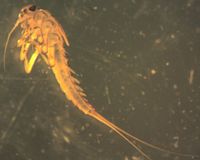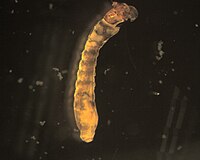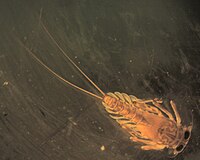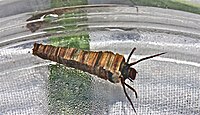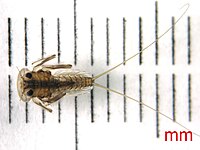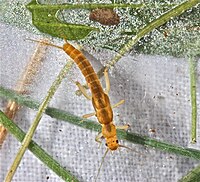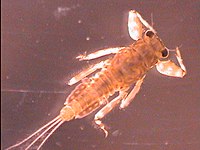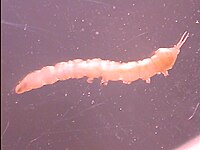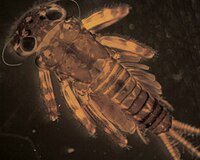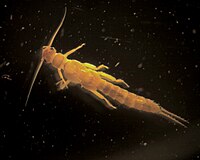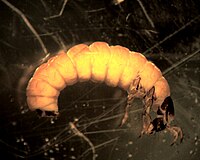Vermont EPSCoR's Streams Project; A Teacher Collaboration on WikiEducator
Openly shared content, practices, and developing resources from Vermont EPSCoR's Streams Project. Join this collaboration and make a difference!
 Miller’s Run Tributary |
|---|
|
| Stream code: | PSR_MRTribA_1232 |
| Basin: | Passumpsic River |
| State or Province: | Vermont |
| Country: | USA |
| Latitude: | 44.601379 |
| Longitude: | -72.121196 |
| School: | Lyndon High School 2 |
The following are the most common invertebrates collected from this stream site.
Baetis
- Order
- Ephemeroptera
- Family
- Baetidae
- Genus
- Baetis
- Common name
- The Little Olive
- Tied fly
- Sawyer Pheasant Tail Nymph
This mayfly has three "tails" and a unique head shape. Its gills are oval shaped and insert dorsally. More mature nymphs have long, dark wing pads.
Image of the long, dark wing pads.
Simuliidae
- Order
- Diptera
- Family
- Simuliidae
Simuliidae appear rather like bowling pins with heads. Relatively speaking, we collect few members of this family and have we have not identified them past family at this point.
Click here for a close up image of the heads.
Epeorus
- Order
- Ephemeroptera
- Family
- Heptageniidae
- Genus
- Epeorus
- Common name
- The Quill Gordon
- Tied fly
- Quill Gordon
This is the only Heptageniidae genus present in this area with two tails!
Brachycentrus
- Order
- Trichoptera
- Family
- Brachycentridae
- Genus
- Brachycentrus
- Common name
- The Olive Dun Caddis
- Tied fly
- Deer Hair Caddis
These larvae are typically found with their legs extended out of their case for feeding. The cases are square in cross section and made of plant materials. Brachycentrus has 2 large sclerites on the metanotum. In fresh samples (preserved for less than one week) these organisms often have a pale green tint; live specimens are a more vivid green.
Heptageniidae
- Order
- Ephemeroptera
- Family
- Heptageniidae
- Common name
- flatheaded mayfly
- Tied fly
- Light Cahill, Wingless Pale Evening Dun
This family of mayflies can be characterized by their distinctly flattened heads and striking resemblance of the character 'Jack Skellington' from the movie 'The Nightmare Before Christmas.' This family can either have two or three cerci (tails).
Commonly encountered genera include:
Epeorus
Heptagenia
Maccaffertium
Rhithrogena
Leuctra
- Order
- Plecoptera
- Family
- Leuctridae
- Genus
- Leuctra
This family of stonefly is fairly slender by stonefly standards. The divergent wing pads are a helpful characteristic. Leuctridae are similar in overall shape to the Capniidae; however, Leuctridae often do not have pleural folds. If they are present, they only extend from abdominal segments 1-7.
Leuctra are recognized by abdominal terga with posterior fringes of short hairs and last few segments with longer hairs.
Image of the divergent wing pads.
Hydropsychidae
- Order
- Trichoptera (caddisfly)
- Family
- Hydropsychidae
- Common name
- net spinning caddisfly
- Tied fly
- Emergent Sparkle Pupa, Vermont Hare's Ear
This family of net-spinning caddisflies is very abundant at several sites. They are important filtering collectors and are quite common at urban and agricultural sites where particles of organic material can be important food resources. Genus-level identification is possible for mature specimens and we will include the genera we found at your site if possible.
When using the key, some features that are challenging to see are the forked trochantin and the paired sclerites in the folds between segments. Other, more easily seen key features include filamentous gills on the abdominal segments and the sclerotization of the dorsal surfaces of all three thoracic segments. Keep in mind that with smaller or more immature specimens, genus-level ID may not be possible.
Commonly found genera include Cheumatopsyche, Ceratopsyche, and Hydropsyche. Less commonly, we have found Arctopsyche and Potamyia.
Images of the forked trochantin and the paired sclerites.
Ephemerellidae
- Order
- Ephemeroptera
- Family
- Ephemerellidae
- Common name
- spiny crawler mayflies
- Tied fly
- Blue-Winged Olive
The mayfly
Ephemerellidae is distinguished by the absence of gills on the second abdominal segment; individuals either have gills on segments 3-7 or 4-7. Some may have operculate (plate-like) gills on the fourth segment, though in many the gills are of identical size. The most commonly found genera include
Drunella,
Ephemerella, and
Serratella.
More information on the genera Drunella, Ephemerella, and Serratella.
Chironomidae
- Order
- Diptera
- Family
- Chironomidae
- Common name
- Nonbiting midge
- Tied fly
- Griffith's Gnat
Midge larvae tend to be the most common macroinvertebrate at our sites. As with other Diptera, there are no true jointed legs. Chironomidae do have a pair of prolegs at each end and preserved individuals tend to curl into a 'C'. Identification past family requires slide-mounted heads. We have seen philopotamid caddisflies misidentified with the chironomids and we suspect that that happens when samples are being sorted from trays. Under a microscope, six prominent legs can be seen on members of the caddisfly family Philopotamidae.
More information on Philopotamidae.
Dicranota
- Order
- Diptera
- Family
- Tipulidae
- Genus
- dicranota
Dicranota can be distinguished by the two tails and their comb feet. There are usually 5 pairs of prolegs on the abdomen with combs on them. In addition, the posterior portion of the abdomen often has a slight swelling.
Image of the prolegs.
Maccaffertium
- Order
- Ephemeroptera
- Family
- Heptageniidae
- Genus
- Maccaffertium
- Common name
- The March Brown
- Tied fly
- March Brown
This genus of
Heptageniidae is distinguished by its gills on the seventh abdominal segment, which are reduced to slender filaments. Gills on segments 1-6 are truncated.
Images of the slender filaments, and the truncated gills.
Alloperla
- Order
- Plecoptera
- Family
- Chloroperlidae
- Genus
- Alloperla
Chloroperlids stoneflies are quite slender relative to most other stoneflies. The adults are green but this trait does not show up in the nymphs. Chloroperlids from this genus are characterized by a fringe of intrasegmental setae on their cerci.
Image of the intrasegmental setae.
Glossosomatidae
- Order
- Trichoptera
- Family
- Glossosomatidae
- Common name
- saddlecase caddisfly
Larvae in this family build domed cases made of small rocks, and are often wider at segment 5. The pronotum is covered in dark, sclerotized plates, but there are either
no sclerites on the mesonotum, or the mesonotum is unsclerotized with the exception of a few patches. The anal proleg is broadly joined to segment 9; the anal claw has one or more accessory hooks. The
pronotal excision is small (approximately 1/3 anterolaterally) to accommodate the coxae.
Commonly encountered genera include Glossosoma and Agapetus.

